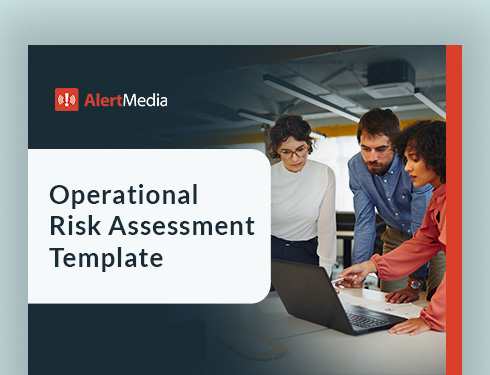Regulatory burden can be expensive. Learn how compliance risk assessments keep you ahead of the curve.

What a Compliance Risk Assessment Is and Why It Matters

Imagine wiping out 35% of your company’s annual net income with the stroke of a pen. That’s the stuff of nightmares for business leaders. It’s even worse when it’s entirely preventable—and the result of your organization’s choices.
For TD Bank, this unfortunate scenario was a fully realized one. In October 2024, they agreed to $3.1 billion in fines to settle anti-money laundering compliance claims by the U.S. government.
Not every compliance failure results in billions of dollars in fines. However, companies in every industry face stringent regulations across their operations. Protecting your business means clearly understanding the laws, standards, and policies you must follow—and the real risks of not doing so. That’s where compliance risk assessments come in.
In this article, we’ll explore what compliance risk assessments are, why they’re a critical piece of your corporate risk management strategies, and how to navigate the process.
Operational Risk Assessment Template
What Is a Compliance Risk Assessment?
A compliance risk assessment is a process to help businesses identify, prioritize, and reduce the risks of not meeting laws, regulations, and internal policies. While internal rules might seem less important than laws, they’re critical to compliance and can factor heavily into insider risk management.
Potential risks vary widely by industry, but some of the most common compliance hazards include:
- Information security vulnerabilities and data privacy laws, such as HIPAA or GDPR
- Potential OSHA violations or other workplace health and safety regulations
- Environmental protections and rules surrounding toxic chemicals
- Financial regulations, including public data and tax information reporting
- Legal and contractual obligations
In many cases, non-compliance results in multiple types of damages. For example, TD Bank’s failure to comply with anti-money laundering regulations resulted in heavy fines, reputational damage, and forced significant operational changes.
Other potential problems include:
- Financial penalties or lost revenue
- Physical injuries to employees, vendors, or clients
- Operational interruptions or suspensions
- Reputational harm
Key Benefits of Compliance Risk Assessments
Beyond simply being the right thing to do, a strong regulatory compliance program creates several benefits for your company:
- Mitigate risks before they materialize: As many safety leaders know, regulations are often written in blood. Laws, standards, and regulations are designed to address past problems. Following them will keep your organization from experiencing the same negative outcomes others did in high-risk endeavors.
- Ensure operational continuity: Any compliance hazard creates a scenario that can interrupt your business. While non-compliance is a problem in itself, businesses face costly remediation and severe legal, financial, or regulatory consequences.
- Prevent legal and financial consequences: In many cases, compliance risks could destroy your business entirely, either by wiping out your finances or legally barring you from working in a specific field. Maintaining compliance keeps your company financially viable and in good standing.
- Protect your company’s reputation: Your clients, vendors, and employees count on you to operate legally, safely, and in accordance with industry standards. Failing to maintain your organization’s compliance can erode trust and risk both present and future relationships.
Video: How to Conduct a Risk Assessment
This video will help you facilitate an effective risk assessment at your organization.
Navigating the Compliance Risk Assessment Process
Performing a compliance risk assessment is a seven-step process:
1. Define the scope
First, decide which parts of your business you’ll include in the compliance risk assessment. In some cases, this will be all departments, locations, and initiatives. Other times, you might focus on one business unit or process, doing a deep dive into its unique compliance risks. Regardless of scope, make sure stakeholders are represented in all relevant areas.
2. Identify applicable regulations
Once you’ve defined the scope, identify all the laws, regulations, and standards you need to maintain compliance. The specifics will vary widely by industry and location, but some of the common types of rules include:
- Federal, state, and local laws
- Industry-specific regulations, such as HIPAA in healthcare or GAAP in financial services
- OSHA regulations
- Service-level agreements, contracts, and other legal agreements with clients and vendors
- Internal policies
- Data protection and privacy rules
3. Identify risks
Next, map your business operations to applicable laws and determine where they meet. These are the spots where you have risk, and you will need to include them in your risk register.
Say, for example, you’re a regulatory leader at a pharmaceutical company. One of your most significant risk factors is compliance with FDA regulations. But you’ll also need to track risks across financial reporting, contracts, and other supporting business categories.
4. Analyze, evaluate, and prioritize risks
The items you discovered during risk identification aren’t equal, and you don’t have the resources to address every hazard your company faces. During the risk analysis phase, ask two key questions about them:
- How likely is it that the risk will materialize?
- How impactful would it be if the risk occurs?
Based on those two factors, you can build a risk matrix to visualize the likelihood and potential impact of your compliance risks. You’ll want to focus your efforts on the most likely and impactful risks, while you ignore unlikely or low-impact risks—or deal with them as resources allow.
5. Assess existing controls
Unless you’re a brand-new company, you probably already have internal controls and risk prevention steps in place. Work through your current policies and procedures to see how they work and whether they need updates to match changes in your business or new regulations.
At this stage, it’s critical to identify gaps and compliance issues and treat them as an opportunity to improve rather than a past failing. Risks can be missed when business units silo their operations and/or expertise, so company-wide cooperation is key to finding compliance gaps.
6. Develop mitigation strategies
Now that you’ve created a list of compliance requirements and gaps in control, you can develop mitigation and prevention strategies. These will often be risk mitigation plans tailored to your company’s operations and processes.
However, there are many industry-wide resources to use. For example, financial services companies should be familiar—and compliant—with FFIEC business continuity guidelines. When it comes to digital operations, DORA compliance can help your company remain resilient, even if you’re not strictly subject to the guidelines.
7. Monitor, review, and document
Lastly, compliance risk assessments should be treated as an ongoing process. Perform internal audits to monitor and review the outcomes of your risk assessment frequently and document your successes and failures. These outcomes are critical to guide your next iteration, in corrective actions and strategies to scale or re-implement.
Wherever possible, use dashboards and automated tools to monitor your risk controls. These can help spot minor problems in real time before they become big and find anomalies in large amounts of data that a human would be unlikely to detect.
Common Compliance Risk Assessment Challenges
Just like complex regulations, compliance risk assessments can be hard to manage. Here are common challenges and pitfalls to avoid:
Intricate and evolving regulations
Understanding and implementing complex, ever-changing regulations requires significant expertise. For example, ISO reviews its standards every five years. Keeping up with the evolving rules—or lobbying to guide the regulatory environment—adds another layer of complexity. Keeping up, or even shaping, these rules multiplies compliance efforts, making it a gargantuan task for any company.
Large companies use specialized legal compliance teams, but businesses of any size can also benefit from industry groups. These groups often simplify complex regulations through educational content and workshops, helping you stay informed.
Global operations and varying jurisdictions
If you operate across jurisdictions, you can expect added complexity. For example, a business with locations in all 50 states has to comply with federal laws, each of the 50 states’ laws, and local regulations. And if your company operates internationally, that complexity skyrockets. Consider an international firm juggling regulations across several states, countries, and regional bodies like the EU.
Jared Greene, the Head of Global Security and Safety at Vuori, touched on this while discussing scalable security strategies. “There are so many different compliance laws and standards and measures, even domestically,” Greene noted. “For instance, if I’m building an occupational health and safety program, as I am now, there are stricter regulations and standards in California, New York, Illinois, and perhaps Massachusetts than there are in Texas and Idaho. But then, when you step out of the country, there’s something called GDPR in Europe, and it definitely behooves me to have a strong understanding of that, because it tells me how different some of those regulatory standards are.”
Resource constraints
In the modern business world, running lean is a common trend. As everyone is asked to do more with less, compliance risk assessments can be harder. This is especially true for more specialized regulatory sectors and industries with significant inherent risks.
Say your company does business in an area with extremely complex guidelines. You might not do enough volume in the space to justify a full-time regulatory expert. But you also can’t ignore the compliance risks.
These expertise gaps can be difficult to fill, especially for small and medium-sized companies. Consultants can often fill knowledge gaps, but they’re costly and may not always align with your company’s vision and priorities.
Managing third-party risks
The scariest compliance risks are the ones outside your organization. Your clients’ and vendors’ actions, processes, and systems can also expose your company to risk.
One of the most common third-party compliance risk areas is cybersecurity. For example, any company with e-commerce operations uses a payment processing provider to handle credit card transactions. If your payment processor isn’t PCI DSS compliant, it can expose you to significant risk.
Interpreting regulations
In general, regulatory bodies try to set forth clear laws and standards. But even with good intent, some points remain vague and open to interpretation. While this provides some flexibility, it also creates risk if your reading differs from that of the decision-makers. Regulators will often publish letters of interpretation, such as OSHA’s online portal, which provides this resource.
However, untested or unclarified regulations can be a significant compliance risk. In many cases, it’s better to proactively work with governing bodies to gain clarity on their interpretation, rather than make assumptions and hope for the best.
Best Practices for Effective Risk Assessments
Here are six ways to make sure you’re getting the most out of your compliance risk assessment:
- Involve cross-functional teams: To eliminate compliance gaps, take a holistic approach involving your company’s business units. Each department might have its own detailed action plan, but every unit should be represented at the company-wide planning level.
- Assign ownership for the risk management program: Set a clear expectation of who controls the compliance risk management process and ensure they have support from senior management and the board of directors. The role varies by company, but it will usually be someone from your regulatory, legal, or security teams.
- Make compliance a core cultural competency: Ignoring compliance until the last minute creates more work and increases the chances of failure. By making compliance part of your company culture and planning, you can avoid costly mistakes and keep your operations running smoothly and within regulations from day one.
- Use governance, risk, and compliance (GRC) tools: GRC tools are valuable for streamlining regulatory processes and making compliance more efficient through automation. Integrating AI risk management into your toolset can help your team work smarter and discover hidden compliance risks.
- Regularly update compliance risk assessments: Neither your business nor regulations is static. Consistently reviewing your compliance risk assessment will catch changes on both sides of the equation and allow you to update mitigation strategies accordingly.
- Provide ongoing training: As your compliance risk mitigation plans change, be sure to update and re-train stakeholders. Communicate changes as soon as they occur and regularly provide employees with education, training, and practice opportunities.
The regulatory landscape can be complex, especially in tightly controlled industries like finance and healthcare. A thorough compliance risk assessment can ensure your organization meets its regulatory obligations and avoids costly penalties or painful operational interruptions.





